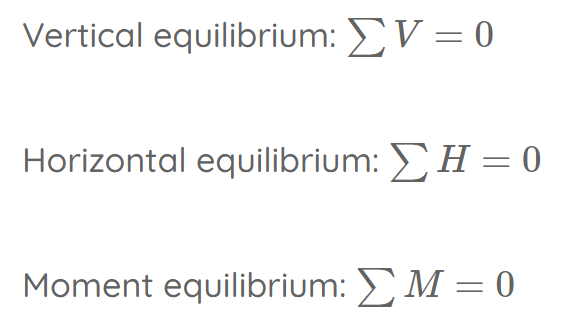Static Indeterminate And Determinate Systems
Post #2 of the Engineering Mechanics Series
Hi friends, 👋👋
Last week, we talked about the different static systems that we use in structural engineering. All these static systems are either statically determinate or indeterminate. Whether a structure is statically determinate or not has a big influence on the calculation of the internal forces. So today, we’ll discover what statically determinate and indeterminate systems are, example structures and how you can calculate the degree of indeterminacy.
So let’s get started. 🔥🔥
What is a statically determinate structure?
Statically determinate structures are structures in which the reaction forces and the internal forces (shear force, normal force, bending moment) can be calculated by the 3 Equilibrium equations.
In one of our next posts, we’ll show how you calculate reaction forces and internal forces of statically determinate structures.
Example statically determinate systems are
Simply supported beam
Cantilever beam
Column with roller and pin support
3-hinge arch
Trusses if modelled with hinges in all nodes
What is a statically indeterminate structure?
Statically Indeterminate Structures are structures in which the reaction forces and the internal forces CAN NOT be calculated by the 3 Equilibrium equations.
When trying to solve the 3 Equilibrium equations for an indeterminate structure, you will experience that you have 4 or more Unknowns (Reaction & Internal forces) for 3 equations.
So how do we calculate the reaction forces and internal forces of indeterminate systems?
Well, in uni you’ll learn very complicated methods such as the Force Method or the Slope Deflection Method. An interesting fact is, that these methods are so complex that almost nobody got the correct result in my course. Back then, we had to calculate everything with paper, pen and a pocket calculator, which makes it easy to do mistakes but gives you a better understanding of the formulas. 5 hours of exam turned into 20-30 pages of calculations. Anyways, as structural engineers, we use either software programs or formulas to calculate the reaction forces and internal forces. These software programs have implemented these “complicated” methods, we can quickly get a result.
Example statically indeterminate systems are
Continuous beams
Frames
Trusses with continuous members
Etc.
Determinacy equations
To find out whether a structure is determinate or indeterminate, we’ll use a formula which is based on parameters of the static system. We’ll differentiate between beams and frames and trusses.
Beams & Frames
The degree of indeterminacy D for beams and frames is calculated as
Where,
n = number of members
r = external restraints (number of support reactions)
j = number of joints
c = number of releases introduced (internal hinges)
So, let’s look at an example.
3 span continuous beam
The 3 span continuous beam has 3 members (beams), 5 reaction forces (1 pin support = 2 reaction forces, 3 roller supports = 3 reaction forces), 4 joints and 0 internal hinges.
D = 3 * 3 + 5 - 3 * 4 - 0 = 2
This means that the structure is statically indeterminate to the 2nd degree and reaction forces and internal forces can not be calculated by the 3 equilibrium equations.
Trusses
The degree of indeterminacy D for trusses is calculated as
Where,
n = number of members
r = external restraints (number of support reactions)
j = number of joints
So, let’s look at an example.
Warren truss
The 3 span continuous beam has 11 members, 3 reaction forces (1 pin support = 2 reaction forces, 1 roller support = 1 reaction forces) and 7 joints.
D = 11 + 3 - 2 * 7 = 0
D = 0 means that the structure is statically determinate. The reaction & internal forces can be calculated by the 3 Equilibrium equations.
Conclusion
Static indeterminacy is an important fundamental in structural engineering, as it influences the internal forces we design our structures for.
I hope this second part of the engineering mechanics series was helpful to you and that you could gain some practical knowledge from it.
This was it for this week. Hope to see you next Wednesday for the #3rd post about Engineering Mechanics.
Have a great rest of the week. ✌️✌️
Cheers,
Laurin.








Great information ... explained in a simple way. It's super. Thanks a lot.
It was a really good explanation without redundancy. Also very helpful to understand this topic. Thank you very much!